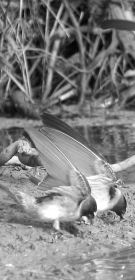by Bruce Swinehart

No story of Spring would be complete without mention of the return of the swallows. This romanticized event is familiar to almost everyone. The swallow most often referred to is the cliff swallow, Petrochelidon pyrrhonota.
This sparrow-sized bird has the characteristically pointed wings of the swallow but is the only swallow with a square tail. The creamy-white forehead, blackish back and light brown rump spot make identification positive. The gourd-shaped mud nests are built in colonies under eaves, bridges, etc. Where these places are not available to them, they nest on rough cliffs or almost any other place they can attach their nests to. The availability of mud is an important factor.
The fact that the nests are closed on top gives them greater versatility in nesting than the barn swallow whose nest is an open cup.
Food of this fascinating summer visitor is evidently 100 percent insects. The quantity consumed by a breeding colony is tremendous. Nestlings are fed almost their own weight every day while adults will eat nearly half their weight. Insects are generally caught while on the wing. The beneficial aspect of this species should not be underestimated, and they should be protected at all costs. Large-scale insect spraying can have a disastrous effect on them. They are, of course , protected by state and federal law. The nests also come under legal protection as soon as an egg is laid in them.
The cliff swallows start arriving in central California in February. The peak of the migration is in early May. We find them along our creeks where there are nesting places like culverts, bridges and buildings with eaves. I have not noticed as many birds this year as I have in the past.

The birds spend their spring and summer in nest building, incubation, and preparing the young birds for the long migration to the remote parts of Brazil. The young must be ready for the long migration so the birds are on a narrow time frame. They all leave the area by the end of September.
At Mission San Juan Capistrano, legend has it that they always arrive on March 19th, St Joseph’s Day. There are several different legends as to why the birds come on this particular day. Birds that arrive early are either ignored or called “scouts.” Natives, however, were hard pressed to define the purpose of the scouts since they certainly did not fly back to South America to warn the other birds. According to the legend, they leave Capistrano on October 23rd, San Juan’s Day. This migration was made famous by the song “When the Swallows Come Back to Capistrano.” The swallows there are no different than the ones I used to band under the culverts of Highway 50. No one has immortalized them, however, by a song titled “When the Swallows Come Back to the Culverts of Highway 50.” Too bad!
We found after years of banding that the birds do come back to nest in large numbers in the place they were hatched. Many even return to the same area on the walls of the culvert or bridge. These are fascinating little birds, and I am pleased our creek preservation policies encourage them.
This article originally appeared in our Summer 2006 Newsletter